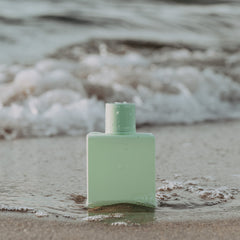Leave No Trace When Camping and Hiking
Everyone who enjoys the outdoors will agree that we should leave nature the way we found it. But sometimes we prioritise convenience over what is really sustainable, or we are just not fully informed yet. 'Leave No Trace' (LNT) is an international movement that aims to teach people how to enjoy the outdoors responsibly. One important principle in the LNT movement is waste, and more specifically, how we use soaps in nature.
Whether you are a hiker, a camper or living the van life, how to properly use soaps, shower gels, and shampoos in nature will help you to leave no trace.
Is Soap Biodegradable?
An ingredient or product is considered biodegradable if bacteria can break it down to at least 90-percent water, CO2, and organic material within six months. Natural soap and even the synthetic detergents, also known as ‘syndets’ such as SLS (Sodium Lauryl Sulphate) and SLES (Sodium Laureth Sulphate), are all considered biodegradable. So yes, soap and even the synthetic detergents SLS and SLES are biodegradable.
Are All Biodegradable Ingredients Harmless for Nature?
While an ingredient might be considered biodegradable, this is under the assumption that it is allowed to degrade somewhere with plenty of microbes, such as soil. If put into a body of water, it will not encounter the same amount of microbes, and can instead wreak havoc on the ecosystem. Biodegradable does not mean that an ingredient can just be put directly into water. While soap is biodegradable, it lowers surface tension of water, and can harm many organisms and microorganisms that rely on that surface tension.
Ingredients to Avoid Altogether in Nature
- Parabens - these are used as a preservative in products which contain water, such as liquid soaps, shower gels and shampoos, which inhibit bacterial growth in water. While parabens are considered biodegradable, they do not degrade well in water, and do significant harm to marine life, causing developmental and hormonal issues. To avoid parabens, check for methyl-, ethyl-, propyl-, butyl- or benzylparaben in the ingredients list, to name just a few.
- Phosphates - Phosphates help to soften hard water which increases cleaning power. They are also biodegradable, but the issue comes from plant-life loving phosphates a little too much! When added to a body of water, plants and algae will grow out of control, depleting oxygen levels, which results in fish and plants dying, and the body of water becoming unsustainable for life. The EU only bans phosphates in laundry and dishwasher detergents, which is a good start, however there are no restrictions in soaps, shower gels and shampoos.
- Triclosan (TCS) and triclocarban (TCC) are antimicrobial chemicals used in antibacterial hand washes. They are chemicals which are known endocrine disruptors, and contribute to bacterial resistance. While these ingredients are currently regulated, but not banned, in North America and Europe, they are still allowed to be sold. It has been found that adding these antimicrobial agents to liquid soap was not more beneficial than using soap which did not contain these ingredients - the cleaning power of soap is in itself sufficient and equally as effective at removing and killing microbes from a surface.
- Other Ingredients - Consider what other ingredients are in your soaps, shower gels, and shampoos such as silicones, fragrance, colourings and even microplastics. These are undoubtedly not easily biodegradable, if at all, and are most likely harmful to the environment. Consider how natural your whole product is, not just the main ingredients, before using it out in nature.
How to Wash out in Nature
Many of us would probably wash ourselves or our dishes at the shoreline, directly in the water. While one person doing this may have a small impact, imagine how many people are visiting this body of water, and how these chemicals can build up.
According to the principles of Leave No Trace, water should be carried at least 60 metres from the shoreline to a shallow pit dug into the soil, and there you can wash yourself or your dishes. Water bottles or a cooking pot are great for transporting water. The shallow hole should be covered with soil afterwards. Dishwater can also be scattered as much as possible. The soil acts as a filter, and gives the products access to bacteria which will break them down before ever reaching the body of water.
Be aware that waste-water can attract animals, so this should be done safely away from the campsite.
Contact With Natural Bodies of Water
While you practice Leave No Trace, you will probably want to cool off and go swimming in the lovely body of water that you are helping to keep clean! Consider what you have on your skin and hair and what impact this could have on the environment. Lotions, sunscreen, insect repellent and body oils can contaminate these vital water sources.
Sources:
https://www.treehugger.com/never
https://www.ncbi.nlm.nih.gov/pmc
https://www.cascada.travel/blog/eco
https://www.ncbi.nlm.nih.gov/pmc
https://www.ewg.org/what
https://pubmed.ncbi.nlm.nih.gov







Leave a comment
Please note, comments must be approved before they are published